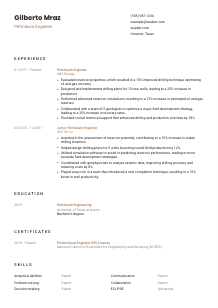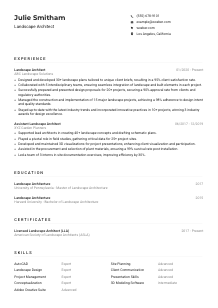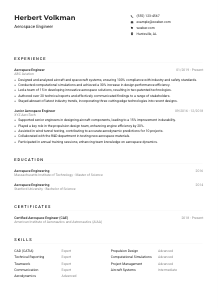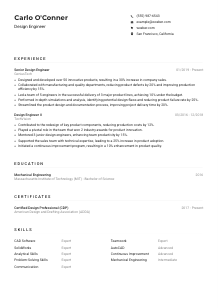Petroleum Engineer Resume Example
Tapping into reserves, but your resume feels dry? Fuel your credentials with this Petroleum Engineer resume example, refined using Wozber free resume builder. Delve into how you can channel your oil and gas expertise to align with job requirements, drilling down a career path rich with potential!
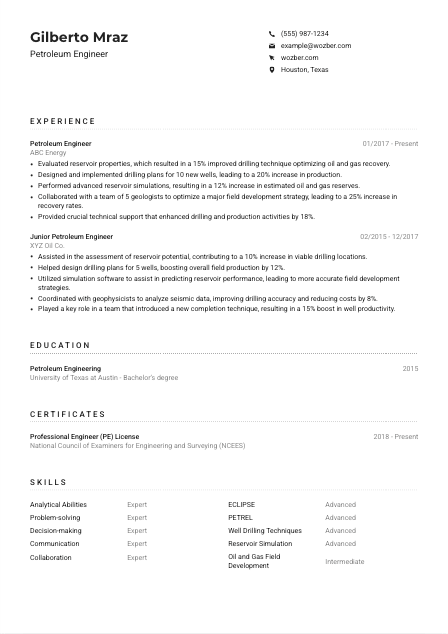
How to write a Petroleum Engineer resume?
Diving into the world of Petroleum Engineering means navigating through reservoirs of opportunities and drilling through layers of competition. As a Petroleum Engineer, your resume isn't just a piece of paper; it's a testament to your ability to tap into energy resources with precision and innovation. Leveraging the Wozber free resume builder, this comprehensive guide is tailored to empower you to create a resume that resonates with the heart of the oil and gas industry. Let's embark on refining your resume into a powerful narrative that propels you towards your dream job!
Personal Details
In the vast reservoir of job applicants, your Personal Details section is the surface marker buoy that makes you visible to potential employers. Let's navigate how to perfect this section for a Petroleum Engineer role, ensuring it not only aligns with job requirements but also positions you as the prime candidate.
1. Brand Yourself with Your Name
Your name is more than just a label; it's the brand you carry into the world of Petroleum Engineering. Make sure it's clearly visible, like a well-designed rig on the horizon. Choose a clean, bold font that stands out yet remains professional.
2. Match the Job Title
"Petroleum Engineer" - these two words are your hard hat in the job market, signaling to hiring managers that you're ready for action. Place this title prominently below your name to immediately draw the employer's attention.
3. Ensure Smooth Communication Channels
- Phone Number: This is your emergency shut-off valve. Make sure it's current and clearly listed. Double-check for accuracy to avoid any unexpected blowouts.
- Professional Email Address: Your digital oil field. Opt for a simple yet professional format, akin to firstname.lastname@email.com, ensuring it's one you check regularly.
4. Be Strategically Located
The job description specifies a need for candidates located in "Houston, Texas." Mirroring this in your resume places you in the drilling sweet spot, immediately aligning with one of the key logistical requirements.
5. Navigate Online Waters
If you have a LinkedIn profile or a professional website that showcases your portfolio, include it. Make sure it's a mirror reflection of your resume, presenting a cohesive professional image across digital platforms.
Takeaway
Think of the Personal Details section as your initial handshake with potential employers. It's the starting drill site for your job search journey. Craft it with care, precision, and an eye for detail, setting the stage for your exploration into the job market. With Wozber's free resume builder, you're equipped to make this section both professional and perfectly tailored to your dream role.





Experience
In the vast landscape of the oil and gas industry, your experience is the crude oil that needs refining into a high-value product. Let's unlock how to distill your work history into a compelling narrative that spotlights your expertise as a Petroleum Engineer, aligning directly with the job's requirements.
- Evaluated reservoir properties, which resulted in a 15% improved drilling technique optimizing oil and gas recovery.
- Designed and implemented drilling plans for 10 new wells, leading to a 20% increase in production.
- Performed advanced reservoir simulations, resulting in a 12% increase in estimated oil and gas reserves.
- Collaborated with a team of 5 geologists to optimize a major field development strategy, leading to a 25% increase in recovery rates.
- Provided crucial technical support that enhanced drilling and production activities by 18%.
- Assisted in the assessment of reservoir potential, contributing to a 10% increase in viable drilling locations.
- Helped design drilling plans for 5 wells, boosting overall field production by 12%.
- Utilized simulation software to assist in predicting reservoir performance, leading to more accurate field development strategies.
- Coordinated with geophysicists to analyze seismic data, improving drilling accuracy and reducing costs by 8%.
- Played a key role in a team that introduced a new completion technique, resulting in a 15% boost in well productivity.
1. Identify the Right Deposits
Begin by dissecting the job description. For example, if it emphasizes "design and implement drilling plans," ready your achievements that mirror this requirement. This step ensures you're drilling in the right direction.
2. Log Your Well History
Structure your experience in a chronological order, starting with your most recent role. For each position, include the job title, company name, and dates of employment. This creates a clear stratigraphy of your professional development.
3. Flow Your Achievements
For each role, articulate your accomplishments and responsibilities, ensuring they resonate with the job requirements. When you've improved drilling techniques or optimized oil recovery, make sure these accomplishments are front and center, just like a well-placed blowout preventer.
4. Quantify Your Reservoirs
Whether it's a 20% increase in production or a 15% improvement in drilling technique, numbers tell a compelling story. They attract attention like a high-performing well, providing tangible evidence of your impact in the field.
5. Drill Down to Relevance
Keep the focus on experiences that speak directly to the job requirements. While your stint as a safety officer may have honed your attention to detail, prioritize the roles that highlight your engineering prowess, ensuring every bullet point hits an oil pocket.
Takeaway
Your experience section is the powerhouse of your resume, driving home the proof that you're the candidate they need. It's about demonstrating your impact in the field with clarity and precision. Tailor each point to reflect your alignment with the job description, showcasing how your engineering feats have led to significant achievements. With each line, you're not just outlining your past; you're paving the way to your future. Use Wozber's ATS-compliant resume features to ensure your experience shines through.
Education
Just as a solid casing supports a well, your educational background lends strength to your resume. For a Petroleum Engineer, showcasing your academic credentials is paramount. Let's delineate how to construct an education section that aligns with your professional aspirations and the job's prerequisites.
1. Map the Formation
Identify the educational requirements stated in the job description. In our case: a "Bachelor's degree in Petroleum Engineering or a related field." This will be the bedrock of your education section.
2. Stack Your Strata
Present your academic history in a straightforward manner. Start with your degree type, followed by the field of study, institution name, and graduation date. This clear layering helps recruiters easily navigate your educational background.
3. Tether to the Bedrock
If your degree directly matches the job requirement, emphasize it. For instance, stating your "Bachelor's degree in Petroleum Engineering" connects directly with the job's foundation, reinforcing your candidacy.
4. Highlight Key Stratifications
Was there a project or course particularly relevant to the role you're applying for? Mention it. This can signal to employers that beyond having the necessary degree, you've also engaged deeply with specific skills or knowledge areas pertinent to Petroleum Engineering.
5. Consider Additional Drill Cores
Beyond the bare degree requirements, did you participate in clubs, organizations, or carry out a significant project or research? Especially for early career professionals, such activities can illustrate passion, initiative, and engagement with the field, adding layers to your profile.
Takeaway
Your education section is not merely a list; it's a narrative of your academic journey, underscoring your foundational knowledge and commitment to the Petroleum Engineering field. Ensure it showcases the depth and breadth of your expertise, resonating with what employers are drilling for. With Wozber's free resume builder and ATS-friendly resume templates, presenting your educational qualifications in the best light becomes seamless.
Certificates
In an industry that values safety, innovation, and technical proficiency, certificates are like the high-grade steel used in drilling equipment – they reinforce your credibility. Let's delve into positioning your certificates to reflect your continual growth and compliance with industry standards.
1. Survey the Terrain
Begin by revisiting the job description for any mentioned certifications. Although our example doesn't specify certifications, including relevant ones like a "Professional Engineer (PE) License" demonstrates adherence to industry standards and continued professional development.
2. Select High-Value Targets
Choose to list certifications that are directly relevant to a Petroleum Engineer's role, prioritizing those that augment your expertise in areas like safety, advanced drilling techniques, or simulation software. This ensures each certificate adds value to your profile.
3. Date Your Discoveries
For certificates with expiration dates or recent achievements, including the dates signals to employers that your knowledge is current and you're committed to staying up-to-date in a fast-evolving field.
4. Continuous Exploration
The oil and gas industry continuously evolves with new technologies and methods. Show a commitment to your professional growth by pursuing and updating certifications relevant to your career trajectory and the demands of the modern Petroleum Engineering field.
Takeaway
By carefully selecting and presenting your certifications, you're not just listing additional credentials; you're showcasing a commitment to excellence and continuous learning in Petroleum Engineering. Let each certification be a testament to your dedication to upholding the highest standards in the industry. Wozber's ATS-friendly resume format ensures that your certificates are showcased effectively for ATS optimization, making your resume as compelling and comprehensible as possible.
Skills
Skills in Petroleum Engineering are like the tools in your drilling kit – essential for getting the job done right. Your resume needs to showcase a blend of technical and soft skills that highlight your aptitude for the role. Here's how to align your skills section with the job's demands, ensuring you're seen as the right tool for the job.
1. Decode the Formation
Extract both explicit and implicit skills mentioned in the job description. For example, proficiency in simulation software like "ECLIPSE" or "PETREL" is explicitly required, signaling a need for technical competence in software commonly used in the industry.
2. Prioritize Your Toolkit
Match and list skills that directly align with those mentioned in the job description. Balancing technical skills with soft skills like "strong analytical, problem-solving, and decision-making abilities" presents you as a well-rounded candidate, just like a well-oiled machine.
3. Organize Your Warehouse
Avoid cluttering your resume with every skill under the sun. Focus on the most relevant ones that speak to the job requirements and your personal expertise. Think of it as organizing your toolbox: keep the most useful tools at the ready, ensuring they're easy to find and use.
Takeaway
Your skills section is a compact display of your professional capabilities. Tailor it to echo the job's language, ensuring that for the hiring manager, choosing you is like selecting the best bit for the job. By highlighting your most relevant skills, you demonstrate not just a match, but a perfect fit for the role. With Wozber, optimizing your skills for an ATS-compliant resume is straightforward, ensuring you're prepared for the drilling ahead.
Languages
The oil and gas industry is a global enterprise, and the ability to communicate across linguistic borders is like having a passport to worldwide operations. Whether liaising with international teams or parsing through global research, language skills can amplify your value. Let's explore how to incorporate your linguistic abilities into your resume effectively.
1. Survey Global Requirements
Start by identifying if the job posting specifies any language requirements or preferences. Our example emphasizes "English linguistic proficiency is required," making this a critical skill to highlight prominently in your resume.
2. Prioritize Communication Channels
If the job description mentions a specific language requirement, emphasize your proficiency in that language first. Demonstrating, for example, native or fluent command of English meets the essential communication skills needed for the role.
3. Add Additional Transmissions
Even if not directly required, possessing additional language skills can be a significant asset, especially in an industry as global as oil and gas. Display these languages to illustrate your ability to engage in diverse cultural and operational environments.
4. Be Clear on Signal Strength
Use straightforward terms to describe your language proficiency, ensuring there's no confusion about your ability to communicate effectively in each language listed.
5. Know the Operational Range
Consider the geographical scope of the role and the company's operations. If it has a broad international presence, emphasizing your multilingual skills could position you as a valuable asset for cross-border communication and understanding.
Takeaway
Highlighting your language skills is like tuning your resume to different frequencies – it increases your range of communication and makes you a valuable asset in a global industry. Whether your proficiency is native, fluent, or conversational, each language you speak adds layers to your professional profile, enhancing your ability to bridge cultures and operations. With Wozber, you can easily tailor your resume to feature your linguistic skills prominently, ensuring they resonate with potential employers worldwide.
Summary
The summary section of your resume is where you set the rig in motion. It's your chance to grab the hiring manager's attention and convey why you're the best candidate for the Petroleum Engineer position. Let's drill down on how to craft a summary that captures your essence and aligns with the role's requirements.
1. Calibrate Your Approach
Begin by absorbing the essence of the job requirements. Reflect on how your experience, skills, and achievements align with what's being asked. This understanding will fuel your summary's direction.
2. Ignite Interest
Start with a strong opening line that positions you within the Petroleum Engineering field, leveraging your years of experience and areas of specialization. "Petroleum Engineer with over 6 years of experience in oil and gas industry" sets the stage powerfully.
3. Channel Your Flow
Incorporate key elements from the job description that match your qualifications. Highlighting your proficiency in simulation software like ECLIPSE or PETREL alongside your successful project outcomes shows a direct alignment with the role's requirements.
4. Refine to Perfection
Keep your summary concise and impactful. Aim for 3-5 sentences that encapsulate your professional identity, your key achievements, and how these align with the job. Think of it as distilling your expertise into a potent mix that's impossible to ignore.
Takeaway
Your summary is the crowning jewel of your resume, offering a glimpse into your professional journey and signaling why you're the prime candidate for the position. By finely tuning it to the job requirements, you underscore your suitability from the get-go. Let your experience, skills, and accomplishments flow seamlessly into a summary that captures your professional essence. Wozber's ATS optimization features ensure that your resume's summary is not only engaging but also tailored perfectly to your dream Petroleum Engineer role.
Launching Your Petroleum Engineer Journey
With these insights in hand, you're now equipped to craft a resume that doesn't just meet the criteria but truly resonates with hiring managers in the oil and gas industry. Your resume is the drill bit to your career aspirations, and with precision, skill, and a bit of Wozber magic, you're ready to pierce through the competition. Remember, it's more than a document; it's a showcase of your professional saga, ready to propel you towards that next groundbreaking role. Set your coordinates, and let your journey to becoming a leading Petroleum Engineer begin!

- Bachelor's degree in Petroleum Engineering or a related field.
- Minimum of 5 years of experience in the oil and gas industry, with a focus on reservoir engineering or drilling operations.
- Proficiency with simulation software such as ECLIPSE, PETREL, or a similar platform.
- Strong analytical, problem-solving, and decision-making abilities.
- Effective communication and collaboration skills to work efficiently with cross-functional teams.
- English linguistic proficiency is required.
- Must be located in Houston, Texas.
- Evaluate reservoir properties to determine drilling and completion techniques that optimize oil and gas recovery.
- Design and implement drilling, completion, and workover plans for new and existing wells.
- Perform reservoir simulations and studies to estimate oil and gas reserves and predict future reservoir performance.
- Collaborate with geologists, geophysicists, and other engineering disciplines to optimize field development strategies.
- Provide technical support to operations teams, ensuring best practices in drilling, completion, and production activities.





